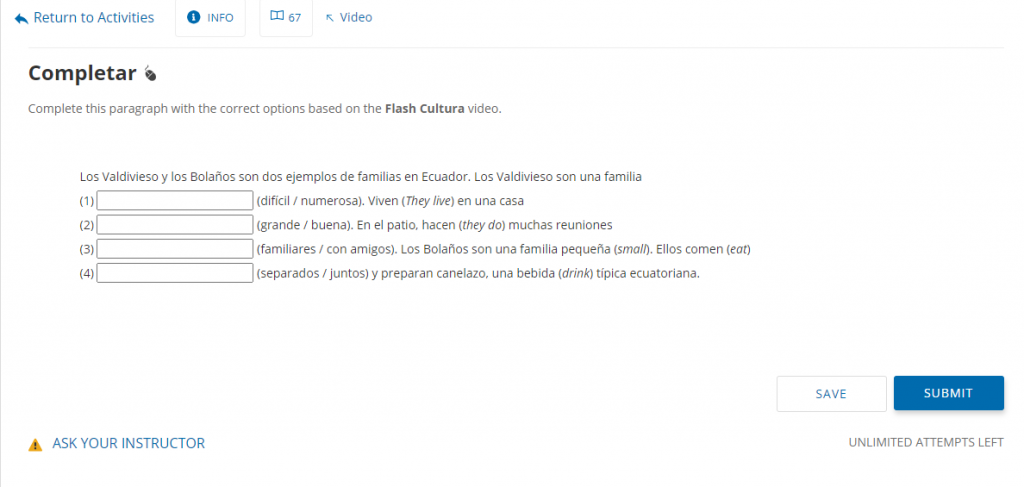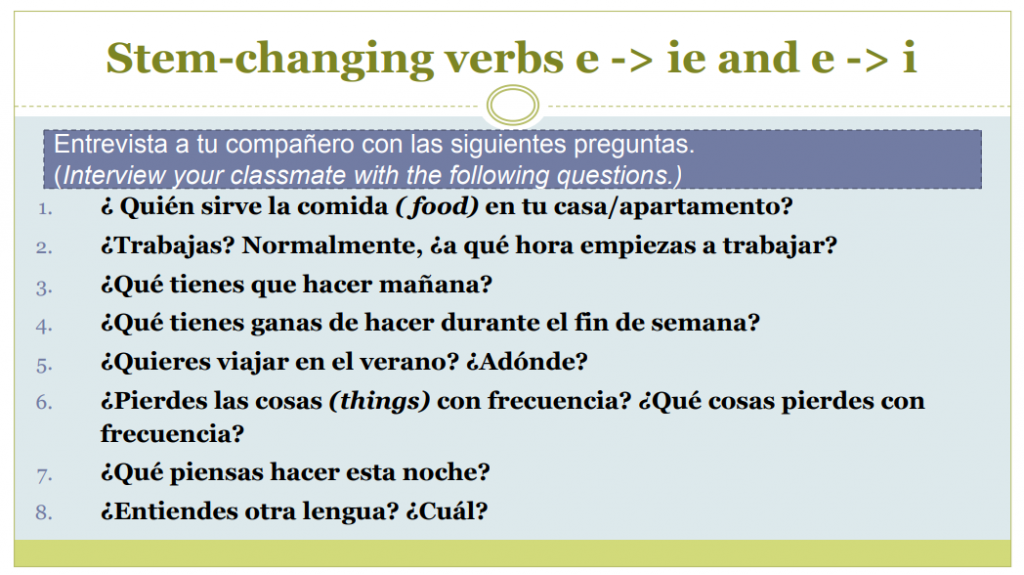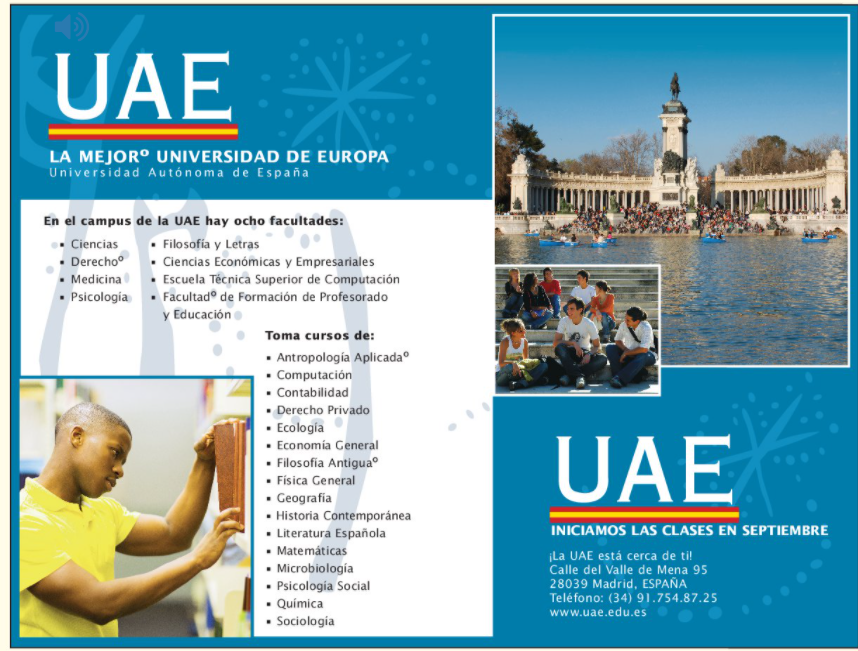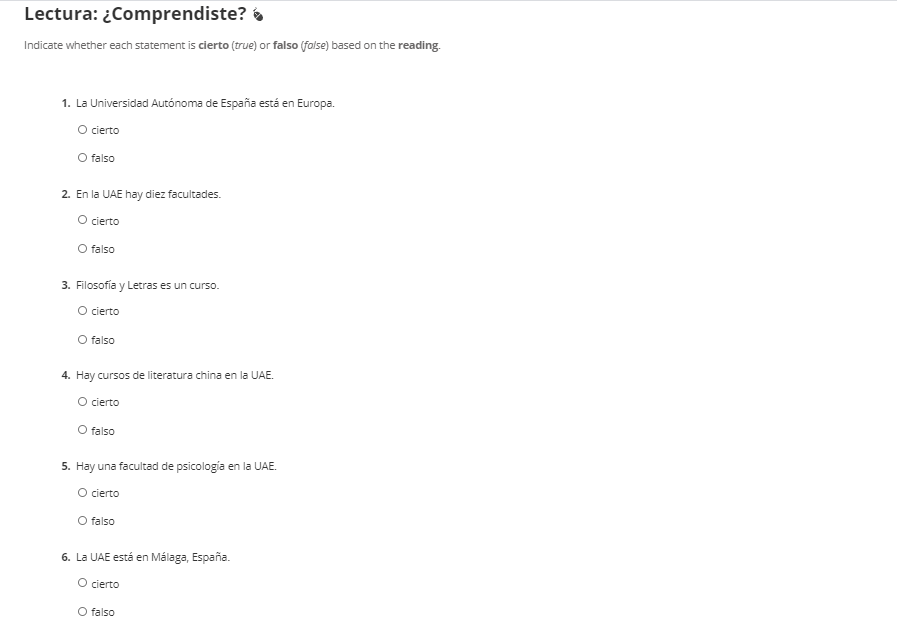Exploring Culture
Over the course of the semester, we were required to complete four different pieces titled “Competencia Cultural”. Throughout these lessons we were able to explore various cultural aspects throughout many hispanic countries such as Argentina, Mexico, and Spain. We were required to watch videos and then recall certain cultural activities and traditions that were brought up in the videos. At the end of the activities we were required to compare/contrast our own traditions with the ones represented in the video.

Before this course I had only been to Costa Rica, which is a Latin-American country with its own unique culture, but that was the only culture I was familiar with. It was interesting to learn that although Latin-American countries are so close together, their cultures are very diverse. Along with that, the accents of people from different Spanish speaking countries are drastically different. An example is above where we answered questions after exploring different families in Ecuador through the Competencia Cultural video.
Engaging in Communities
It is important to engage yourself in a variety of different countries and places. Even if you cannot travel to these places, simply learning of different languages and cultures can help you better navigate the diverse world around you. I haven’t had much time to engage in communities since we were stuck with a pandemic this past year, but I am confident that my growing knowledge in Spanish will help me succeed when I am able to make it back into the world.
Interpersonal Communication
We completed a few activities that required us to communicate with our peers. Every class we participated in interpersonal communication activities that required us to navigate a new subject or topic with our peers. We also had an interview where we were required to ask and answer questions from our peers.

Above is an example of a class activity. We were asked to break into groups and then discuss these questions with our peers. Through these frequent activities and the interviews with our peers our skill levels in speaking and understanding Spanish were challenged. The hardest part for me was being able to piece words together to speak coherent sentences. Activities such as the one above have helped me grow in that aspect. I understand Spanish well and hope to continue being able to grow in my speaking.
Presentational Speaking
We completed another interview with the professor that demonstrated more of our presentational skills. Our professor met with us individually and asked us questions to which we would answer. This measured our ability to understand and speak Spanish.
I struggled a lot with this assignment. I was and still am not completely confident in my ability to speak Spanish, though I am sure I can speak more than I am aware. This caused me to mess my words up, and not do as well as I had planned on this activity. After it was over with I realized that I had let my nerves get the best of me and underestimated my speaking abilities. I am still confident I can do better, and I will continue to practice as I continue my Spanish speaking journey.
Presentational Writing
While we did not do much verbal presentation speaking, we completed a few pieces of writing known as “Composición” one and two. In these pieces we discussed ourselves and our family. The purpose of these exercises was to illustrate our understanding of Spanish and our overall growth.
ComposicionComposicion-2-Final
As you can see from the above documents, my ability to write clearly in Spanish has increased drastically since the beginning of the semester, when the first document was written. As I learned more vocabulary I was able to write out more descriptive pieces. The hardest parts of these activities wasn’t necessarily the vocabulary, but the conjunctions and other connecting words. This got slightly easier with the next piece but still remains something I struggle with. I imagine as I advance in my Spanish learning career it will be something that will come easier to me.
Interpretive Listening
We did various listening activities over the semester. Whether it was on exams or through our homework, we were required to either listen and verbally repeat phrases, or write sentences as we heard them spoken.
The listening activities have helped me grow in my abilities to comprehend Spanish. I found myself having to focus harder on certain activities than some due to different accents and speeds. I found that the more I listened through the activities, the easier I could understand what was being said. Through completing these activities I have found it easier to understand those around me that I couldn’t before. It is truly something that gets easier with practice.
Interpretive Reading
Over the semester we worked on a few assignments titled “Lectura”. For these assignments we had to read various pamphlets and magazine articles from our textbook. Taking the information from these articles, we then had to answer questions about them to express our understanding of these pieces.
These activities were some of the more difficult ones for me. I could pick out and understand certain vocabulary, but there were other words that I found myself having to use context clues for. In this specific activity there were still a lot of words that I didn’t understand or know yet. When having to decipher different classes I often guessed until I eventually figured out the answer. As time went on these activities became more simple as I had grown in my overall vocabulary. These activities challenged my thinking and forced me to grow when I felt like I couldn’t. I know that I couldn’t go on today reading entire novels in Spanish but I am now more confident in my ability to read in Spanish.



